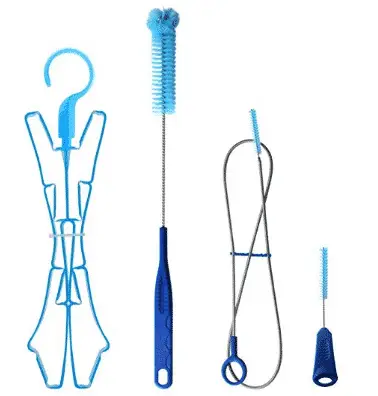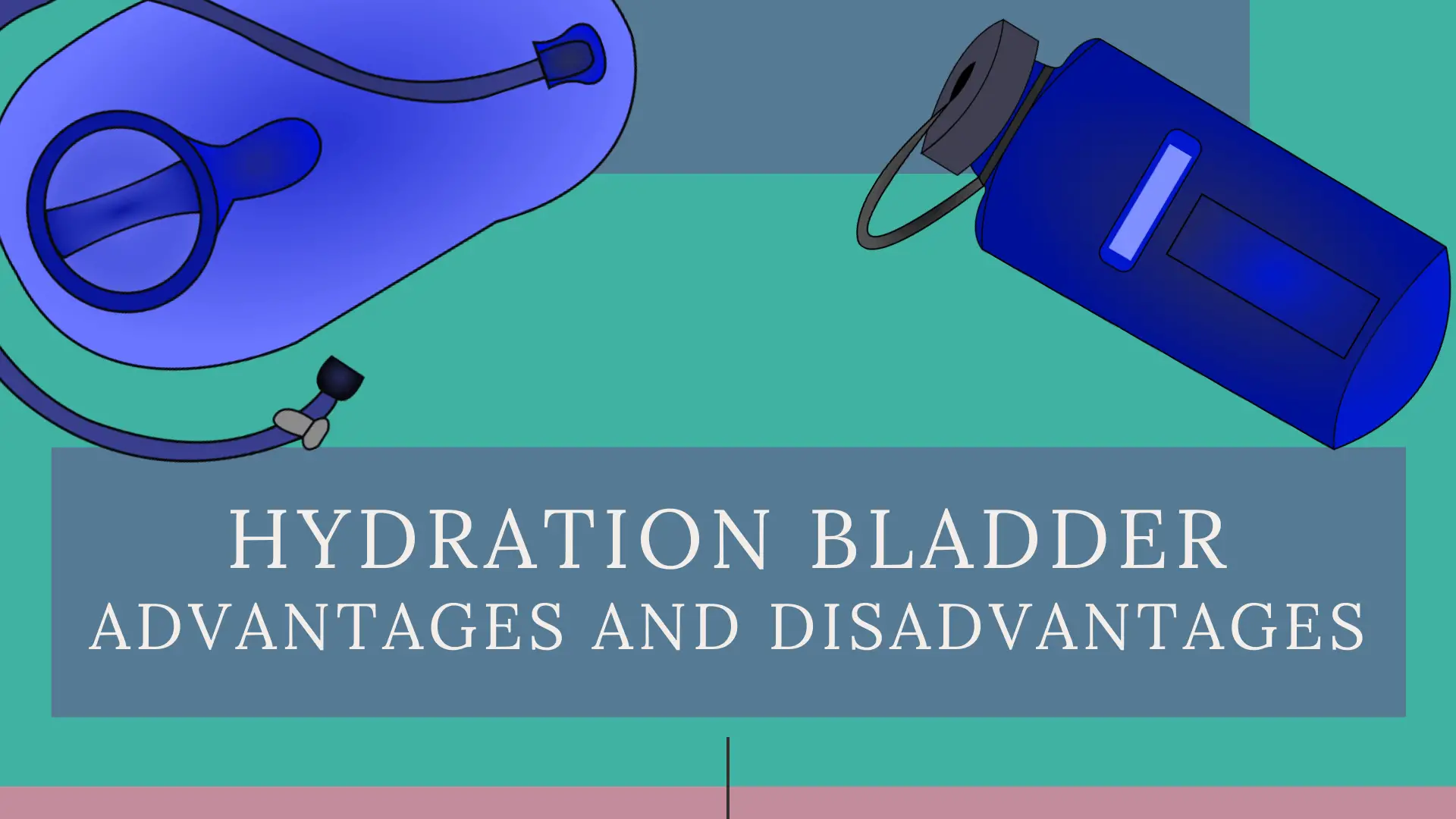At some point in your backpacking life, everybody starts looking into hydration systems. Hikers can’t seem to agree on when/where a hydration bladder is better than water bottles. It all comes down to personal preference, but hydration bladders definitely have pros and cons.
Quick Pros and Cons of Hydration Packs
Hydration bladders have many advantages and disadvantages. Advantages Include: Easier to stay hydrated, won’t run out of water, carry more water, comfortable, easier to carry in difficult terrain. Disadvantages Include: Harder to Clean, Prone to Leaks, Hard to Refill, can’t see how much water is left.
Advantages and Disadvantages of Hydration Bladders
Advantages
- Easier to Stay Hydrated
With their easy access tubes, hydration bladders are easier to use than traditional water bottles. With a water bottle you have to stop, dig around for your bottle, screw off the lid, take a sip, screw the lid back on and put it back in your bottle holder.
That process might only take 30 seconds, but you still have to stop what you’re doing. With a hydration pack you just grab the tube bite down and you’re good to go. There’s no stopping or fooling around with your gear.
It’s so much easier to get in your 1 liter of water for every 2 hours of hike time(maybe more on hot days.
- Less Likely to Run Out of Water
Most backpackers use hydration bladders on long day hikes. Think about the standard size Camelbak hydration bladders. There’s a reason why they come in 1.5 Liter, 2 Liter and 3 Liter variations. It’s the perfect amount of water for 3-hour, 4 hour and 6-hour hikes. That’s how far your average hiker is willing to go in one day.
Think about how many water bottles it would take to match your 3 Liter reservoir. You would need 6 standard water bottles or 3 Large 32oz Nalgene Bottles. Most packs/belts only have room for 2 water bottles.
Some brands even make bladders that come in ridiculous sizes. I’ve seen hydration reservoirs going all the way up to 6+ Liters(who would want to carry 20lbs of water).
- Easier to Carry Extra Water
When you think about how much water you actually need on a 6 or 8 hour hike it’s crazy. You should be drinking 3-4 liters of water over that time period. Imagine trying to carry a pair of coke bottles(2-liter) around for 8 hours. That would be terrible!
Hydration packs spread the weight across your back, so you can easily carry around 10-15lbs of water. That little bit of weight spread along your back is almost unnoticeable.
- More Comfortable
Have you ever had a sore back at the end of a long hike? Lower back pain is one of the most common backpacking injuries(knees might be worse).
Water will probably be the heaviest item in your pack. Considering 1 liter of water weighs 2.2lbs, the average hiker carries between 7 and 8lbs in water alone(including the container).
Think about the backpacking “Big Three”, the heaviest items in your pack(sleep system, tent, and pack). These three items should weigh less than 8-9lbs combined. Water ends up being about 1/3 of your total gear weight.
Luckily, with a hydration pack all that weight can be spread across your entire back close to your body. On the other hand, hydration belts center the weight close to your lumbar region and away from your core. Over time that’s going to put a lot of stress on your lower back.
- Easier to Navigate Difficult Terrain
When you need to navigate through difficult terrain ideally, your heaviest items should be close to your body. You’re trying to keep the weight close to your center of gravity to avoid throwing off your balance.
With bottled water, there’s just no way to center the weight along your body. If you want easy access to your water bottle it has to be on the outside of your pack(which will throw off your weight).
Have you ever tried navigating through thick brush with water bottles strapped to your sides? They end up getting snagged on everything. You risk dropping and smashing your bottles.
Disadvantages of Hydration Bladders
- Hard to Clean

At the end of a long hike the last thing you want to do is clean out your hydration bladder. You have to take out a bunch of gear to access your water reservoir, yank it out and precariously fill it up, rinse it out, and use cleaning tablets(these are the tablets I use). That’s not even how you deep clean the bladder.
Nobody wants to do all that every night on a multi-day hike. It’s so much easier to just drop in a little dish soap and rinse out your water bottle. Plus you don’t have to buy specialized cleaning supplies.
Even if you clean your water reservoir out on the trail you still have to deep clean it at home. You have to buy a hydration bladder cleaning kit and cleaning tablets. There’s no way to avoid buying the tools. You just can’t get the bite tube and inside clean without a specialized brush.
- Harder to Refill
There’s no way to conveniently fill up a water bladder out on the trail. You have to take off your pack and take out a bunch of gear just to access the bladder. It’s just not possible to refill your hydration bladder on the fly.
You never know when you’ll stumble upon a clean water source on the trail. While your buddies are filtering water and refilling their water bottles in a chilly stream you’ll be standing there like a dope.
It’s painfully awkward to fill up your bladder. There’s just no easy way to hold the bag open and fill it up with water.
- Harder to Gauge Water Intake
When carrying water bottles it’s very easy to ration your water intake. If you’re carrying 2 water bottles on a 4-hour hike you can easily figure out the math. Just drink half a bottle of water for every hour you’re on the trail.
You can instantly see how much water you drank over the course of the day. If you aren’t drinking enough it’s easy to adjust your fluid intake.
With a hydration bladder, you have no idea how much you’re drinking(without taking off your pack). There’s no consistency when using the bite tube and there’s no way to visualize just how much water you’re taking in.
- Never Know When Bladder is Running Dry
How do you know when your water bottle is running dry? You feel the weight or look through the side(it’s not that hard). It’s very obvious when your water bottle is almost empty.
There’s no easy way to see how much water is in your hydration bladder. You have to physically take off your pack and dig inside. You’ve got no idea until your bite tube starts slurping and bubbling.
- Sometimes The Bladder Leaks
Hydration bladders are made out of soft plastic so they will eventually wear out and start to leak. The bag will either rip apart at the seams or the screw-on plastic lid will lose its seal. Luckily they are fairly easy to fix so it’s not that big of a deal.
There’s no smashing a plastic Nalgene water bottle. You can put your entire weight on the bottle and it’s not going to bend.
Sometimes You Shouldn’t Use a Hydration Bladder
Throughout my life I’ve bought my fair share of hydration bladders. They’ve been used on short hikes, long hikes, canoe trips, bike rids, etc. Other than a few minor leaks I’ve never had any problem carrying a hydration bladder.
That being said, sometimes it just doesn’t make sense to carry a hydration pack. Sometimes it’s just so much easier to grab a water bottle and go. Hydration bladders are awesome, but they don’t always make sense.
Water Bottles are Better on 1-2hr and Multi-Day Hikes
Personally, I only use my hydration bladder on long day hikes. I just hate having to clean out the tube/bladder between use. It’s such a pain to empty out your gear and refill your bottle on a multi-day hike.
I only like to use my hydration bladder on long 6-8 hour day hikes. On shorter 1-4 hour hikes it’s easier to just fill up a water bottle. I like to go on short 1-2 hour hikes throughout the workweek. Nobody wants to be the crazy guy filling up his hydration bladder in the break room sink.




